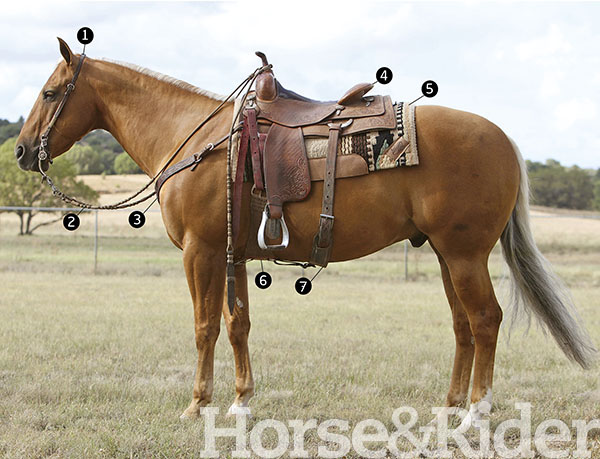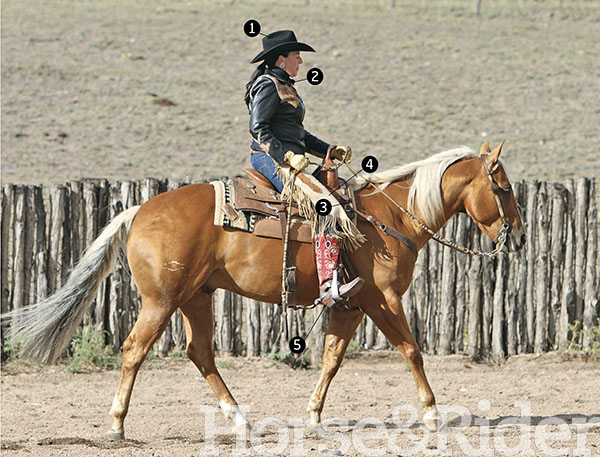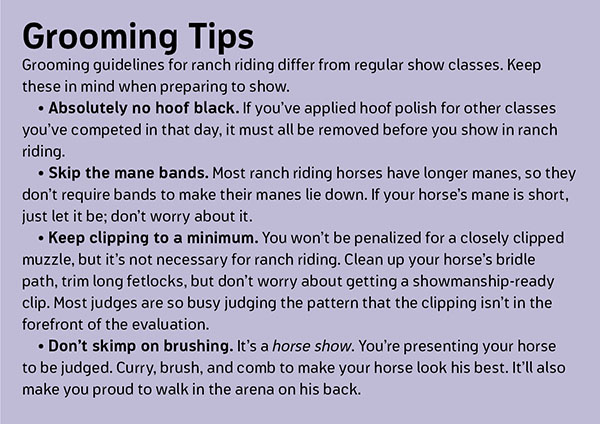Q I’m ready to give ranch riding classes a try. I feel like my horse has the basics down, but I want to be sure that my attire and his tack meet all expectations and follow the rules. What should I keep in mind? How is presentation different than in other show classes, like horsemanship or trail?
[READ: Have a Snappy Ranch Riding Spin]
Valerie Smith, Arkansas
A Ranch riding’s whole purpose is presenting a competent horse-and-rider pair that can do whatever job the pattern calls for. Specific tack and attire rules govern classes in most associations. For example, AQHA rules discourage silver adornments and bling on tack and attire. The important thing is to think working gear and attire that suits the job at hand. You wouldn’t see a cowgirl ride out to fix fence in a fully embellished top and a silver saddle.
Above, you see a photo of one of my ranch riding mounts, fully tacked and ready to show. The opposite page shows me in an example of what I wear in the class. I’ll go over the high points of each photo to give you a strong background in what’s expected in terms of turnout for horse and rider in the class.
My Horse’s Tack
1. Plain leather headstall with rawhide accents. This high-quality, one-ear headstall has solid buckles and plain Chicago screws to attach the bit. You can also choose a sliding-ear or two-ear headstall. If riding in a snaffle bit, use a browband headstall with a throatlatch strap to keep the headgear in place. Adjustment plays a key role. You can see here that my headstall is adjusted to place two small wrinkles in the corners of my horse’s mouth. A snaffle bit would be adjusted slightly lower.

2. Braided rawhide romal reins. Growing up in the Southwest, I’m accustomed to riding with romal reins. Leather split reins are also permitted in the class. Choose whichever you prefer, but be sure you know how to correctly use romals if you opt for them.
3. Leather breastcollar. Tooled leather is permitted in the class, as seen on my breastcollar. It’s adjusted to lie across my horse’s shoulders, and the strap between his front legs is snug. A breastcollar is suggested, but not required. I prefer to see one because it paints the picture that you’re prepared for anything that’ll cross your path.
4. Western saddle. Saddle-style choice lies in your own preference. This horse wears a fully tooled, double-rigged, square-skirt saddle. Silver is discouraged, but there isn’t a penalty for it. As a judge, I’ve seen it used to break ties—if you have a lot of silver, you might lose a tiebreaker.
5. Navajo-topped therapeutic saddle pad. This is another piece of tack that has some leeway. You can show in a plain pad, if that’s what you prefer. I use a therapeutic pad for my horse’s comfort. It has a Navajo-blanket top, which adds a pop of color and design interest.
6. Mohair cinch. I prefer a synthetic mohair cinch because it breathes. Neoprene or fleece-lined cinches are also acceptable. My cinch is tightened by the leather latigo with enough tension to hold my saddle in place, but not cut my horse in half by being too tight.
7. Flank cinch and hobble. My back cinch is adjusted to lie against my horse’s barrel—not hanging down below, where a hoof could get caught in it, nor snubbed too tight, causing discomfort. The hobble is tight enough that there’s no slack to catch on anything and it holds the flank cinch in the appropriate position, rather than letting it slide back too far.
[READ: Ranch Riding Transitions for the Win]
My Attire
1. Western hat. As in any show event, a clean, well-shaped hat sets the tone for the judge. Be sure your hat fits well. My hair is pulled back into a ponytail at the nape of my neck. Many lady ranch riders braid their hair down the center or to the side. Just be sure it’s neat and tidy, with no stray hairs.

2. Neck scarf. I tie a small scarf around my neck with a square knot. You can also use a larger wild rag, or skip the scarf.
3. Leather jacket. Your top is where you can express your personal style. I prefer leather jackets or denim, leather, or fabric vests paired with Western, collared shirts. You can keep it simple with a well-fitted Western, button-up shirt. Just leave the bling at home.
4. Chinks. Chaps aren’t required for ranch riding, but I prefer to wear chinks over my dark-blue denim jeans for a complete look. Other chap options include rough-out chaps, shotgun chaps, and regular show chaps—it doesn’t make a difference, just stay away from ultrasuede because it doesn’t fit the look of the class.
5. Western boots. My chinks let me show more of my personal style, expressed in my tall-top, stitch-embellished boots. Any Western boots are acceptable in ranch riding.
[READ: 9 Tips for Show-Ring Shine]

Laurel Walker Denton, Skull Valley, Arizona, is a lifelong horsewoman and competitor. She grew up on the Bar U Bar Ranch where she and her husband, Barry, reside. Denton, an AQHA and NRCHA judge, has trained and shown horses to great success in working cow horse, reining, and ranch riding. The Bar U Bar Ranch has earned the AQHA 50-Year Breeder award. Learn more about her program at barubar.com.






